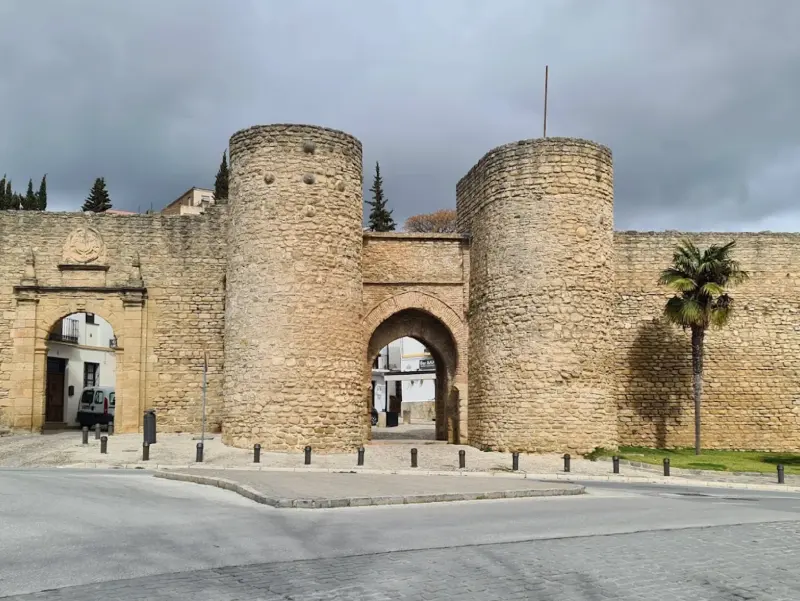Blog
The Almocabar Gate: living history in Ronda’s city walls

The Almocábar Gate is one of Ronda’s most iconic and best-preserved monuments. Located on the southern flank of the city walls, this imposing gate was for centuries the main entrance to the Islamic city and to the Barrio Alto, today known as the Espíritu Santo neighbourhood.
Origin and meaning
Its name comes from the Arabic “Al-maqabir”, meaning “cemetery”, as the old Muslim necropolis was located nearby. Built in the late 13th century during Muslim rule, the Almocábar Gate was designed to protect the most important access to the Alcazaba and the medina of Ronda. Its strategic location on the highest and strongest part of the southern wall made it a key defence point for the city.
Architecture and evolution
The original structure of the gate stands out for its impressive defensive system: it has three successive doors flanked by two semicircular masonry towers that housed guards and supported the closure mechanisms, such as the old portcullis and drawbridge.
The side arches are horseshoe-shaped, while the central one is pointed, showing the opening through which the portcullis or “comb” descended to reinforce security.
In the 16th century, during the reign of Charles I, the Almocábar Gate was restructured and a Renaissance-style entrance section was added, crowned with a large imperial coat of arms held by the Habsburg eagle. This semi-circular stone arch was restored in 1965 and placed alongside the original structure, creating a contrast of styles that reflects the transition from Islamic to Christian times in Ronda.
Over time, the gate has had different names, such as Gate of Ximena, San Francisco, Alameda or Los Caños, and it has witnessed key events for the city. In front of it, in San Francisco Square, on 20 May 1485, Castilian troops led by the Marquis of Cádiz gathered, marking the end of Arab rule in Ronda and its mountains.
Curiosities and surroundings
Among its most striking details are the projectiles embedded in the towers, placed by Christian troops in the shape of a cross to symbolise the conquest and the city’s return to Christianity.
Next to the gate is the historic watering trough known as El Pilar, a traditional meeting point for locals and horse riders, and the start of an old royal drovers’ road.
Even today, you can see women collecting fresh mountain water and horses refreshing themselves under the wall’s protection.
The Almocábar Gate is also the ideal starting point to explore Ronda’s historic centre. Nearby are monuments such as Santa María la Mayor Church, Laurel Castle and Duquesa de Parcent Square.
All this makes it an essential stop for any visitor wanting to dive into the city’s history.
A complete experience: Bodega Doña Felisa
After exploring the Almocábar Gate and Ronda’s monumental surroundings, there is nothing better than ending the day with a visit to Bodega Doña Felisa in Ronda, ranked as the 4th top activity in Ronda on TripAdvisor and among the top 20 things to do in Andalusia.
This family-run winery, located between Ronda and Setenil de las Bodegas, offers:
- Guided tours
- Wine tastings
- Pairings with local products
All in a privileged setting, allowing you to discover the wine-making tradition of the Serranía de Ronda and enjoy an unforgettable wine experience.The Almocábar Gate is not only an architectural gem, but also a symbol of Ronda’s history and identity. Visiting it means immersing yourself in centuries of cultural heritage and enjoying the essence of one of Andalusia’s most fascinating cities.



